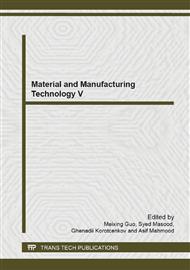p.112
p.116
p.121
p.126
p.132
p.136
p.141
p.147
p.152
Experimental Study of Micro-Milling Microchannels on Polycarbonate Substrates
Abstract:
How to fabricate a disposable microfluidic device is a growing interest in many application fields and micromilling is one of the efficient approaches. The benefits of using micromilling for polymer microfluidic devices include shorter fabrication process, lower cost, easier user interface, and being capable of fabricating complicated structures. The aim of this study is to use factor analysis to determine the optimal cutting conditions in micromilling microchannels on polycarbonate substrates. The parameters included spindle speed, feed rate, and the depth of cut, and the micromilled roughness was measured by a stylus profilemeter. The smallest roughness achieved was 0.127μm with the spindle speed of 20,000rpm, feed rate of 300mm/min, and the depth of cut of 10μm. From factor analysis results, the spindle speed has the largest influence while the depth of cut has the minimized impact to the surface quality of a micromilled polycarbonate substrate.
Info:
Periodical:
Pages:
132-135
Citation:
Online since:
June 2014
Authors:
Keywords:
Price:
Сopyright:
© 2014 Trans Tech Publications Ltd. All Rights Reserved
Share:
Citation:


